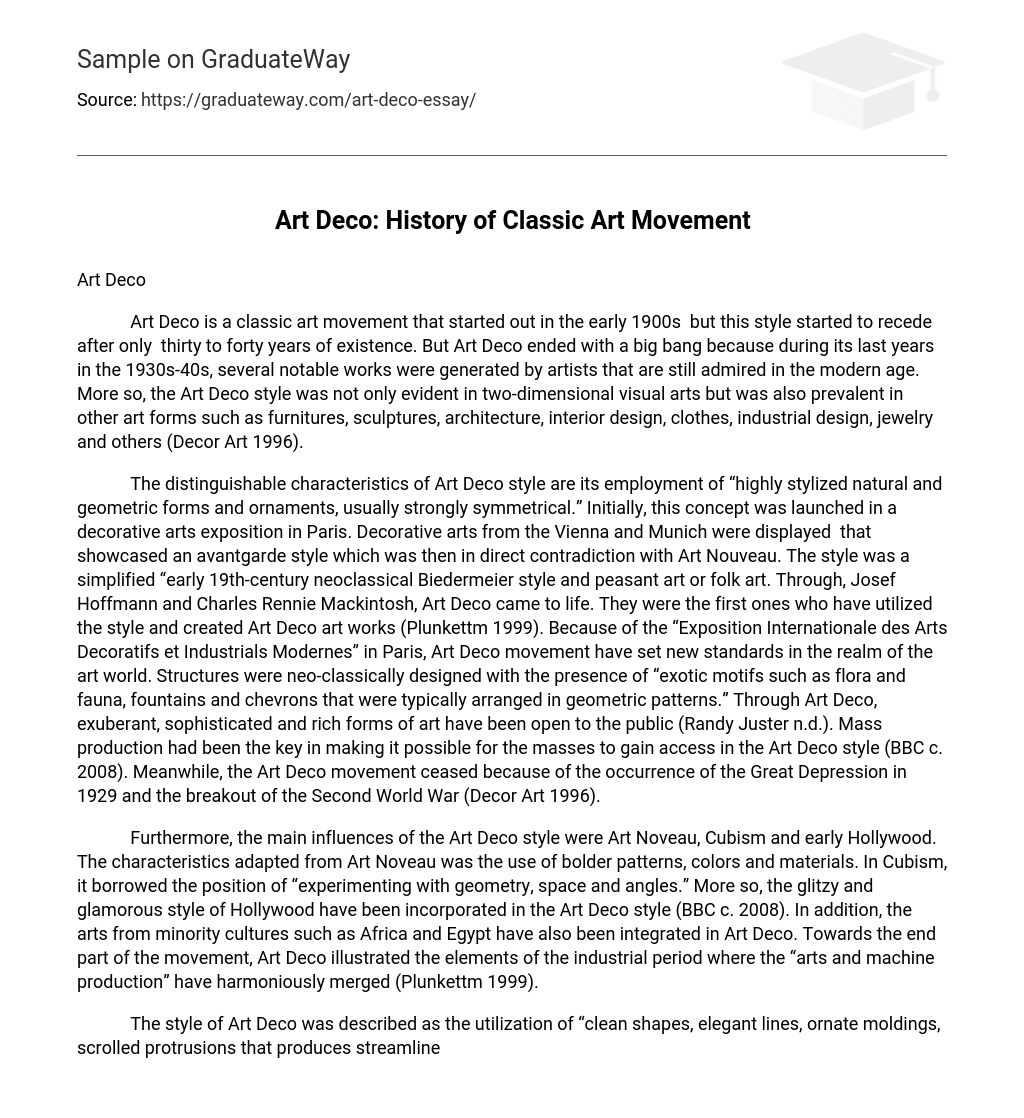Art Deco is a classic art movement that started out in the early 1900s but this style started to recede after only thirty to forty years of existence. But Art Deco ended with a big bang because during its last years in the 1930s-40s, several notable works were generated by artists that are still admired in the modern age. More so, the Art Deco style was not only evident in two-dimensional visual arts but was also prevalent in other art forms such as furnitures, sculptures, architecture, interior design, clothes, industrial design, jewelry and others (Decor Art 1996).
The distinguishable characteristics of Art Deco style are its employment of “highly stylized natural and geometric forms and ornaments, usually strongly symmetrical.” Initially, this concept was launched in a decorative arts exposition in Paris. Decorative arts from the Vienna and Munich were displayed that showcased an avantgarde style which was then in direct contradiction with Art Nouveau. The style was a simplified “early 19th-century neoclassical Biedermeier style and peasant art or folk art. Through, Josef Hoffmann and Charles Rennie Mackintosh, Art Deco came to life. They were the first ones who have utilized the style and created Art Deco art works (Plunkettm 1999).
Because of the “Exposition Internationale des Arts Decoratifs et Industrials Modernes” in Paris, Art Deco movement have set new standards in the realm of the art world. Structures were neo-classically designed with the presence of “exotic motifs such as flora and fauna, fountains and chevrons that were typically arranged in geometric patterns.” Through Art Deco, exuberant, sophisticated and rich forms of art have been open to the public (Randy Juster n.d.). Mass production had been the key in making it possible for the masses to gain access in the Art Deco style (BBC c. 2008). Meanwhile, the Art Deco movement ceased because of the occurrence of the Great Depression in 1929 and the breakout of the Second World War (Decor Art 1996).
Furthermore, the main influences of the Art Deco style were Art Noveau, Cubism and early Hollywood. The characteristics adapted from Art Noveau was the use of bolder patterns, colors and materials. In Cubism, it borrowed the position of “experimenting with geometry, space and angles.” More so, the glitzy and glamorous style of Hollywood have been incorporated in the Art Deco style (BBC c. 2008). In addition, the arts from minority cultures such as Africa and Egypt have also been integrated in Art Deco. Towards the end part of the movement, Art Deco illustrated the elements of the industrial period where the “arts and machine production” have harmoniously merged (Plunkettm 1999).
The style of Art Deco was described as the utilization of “clean shapes, elegant lines, ornate moldings, scrolled protrusions that produces streamlined lines, curves and geometric shapes like stylized foliage and flowers.” The combination of “simplicity, geometry with simple shapes” and bold colors indicated the influence of “technology and commerce” in Art Deco.
In addition, works of “applied art and architecture” were evidences of different influences wherein sophisticated items made out of exotic raw materials that have been marketed publicly and sleek objects that have been accessible to the masses. In a nut shell, the style of Art Deco symbolized luxury and sophistication during the period of simplicity (Masters Lodge c. 2008). The art movement of Art gave an immense contribution to art and society. It provided new ideas and style that satisfied people’s hunger for creativity and innovation.
List of References
- BBC (c.2008) Period Styles available from <http://www.bbc.co.uk/homes/design/period_artdeco.shtml#style>[24 April 2008]
- Decor Art (1996) The Art Deco Story available from <http://www.art- deco.com/general.html> [24 April 2008]
- Juster, R. n.d. Art Deco [online] available from <http://www.decopix.com/New %20Site/Pages/Directory%20Pages/Intro.html> [24 April 2008]
- Masters Lodge (c.2008) Art Deco Style available from <http://www.masterslodge.co.nz/hawkes_bay/art_deco_style/art_deco_style.ht>
- Plunkettm, E.M. (1999) Art Periods: Art Deco available from <http://www.discoverfrance.net/France/Art/deco.shtml> [24 April 2008]





